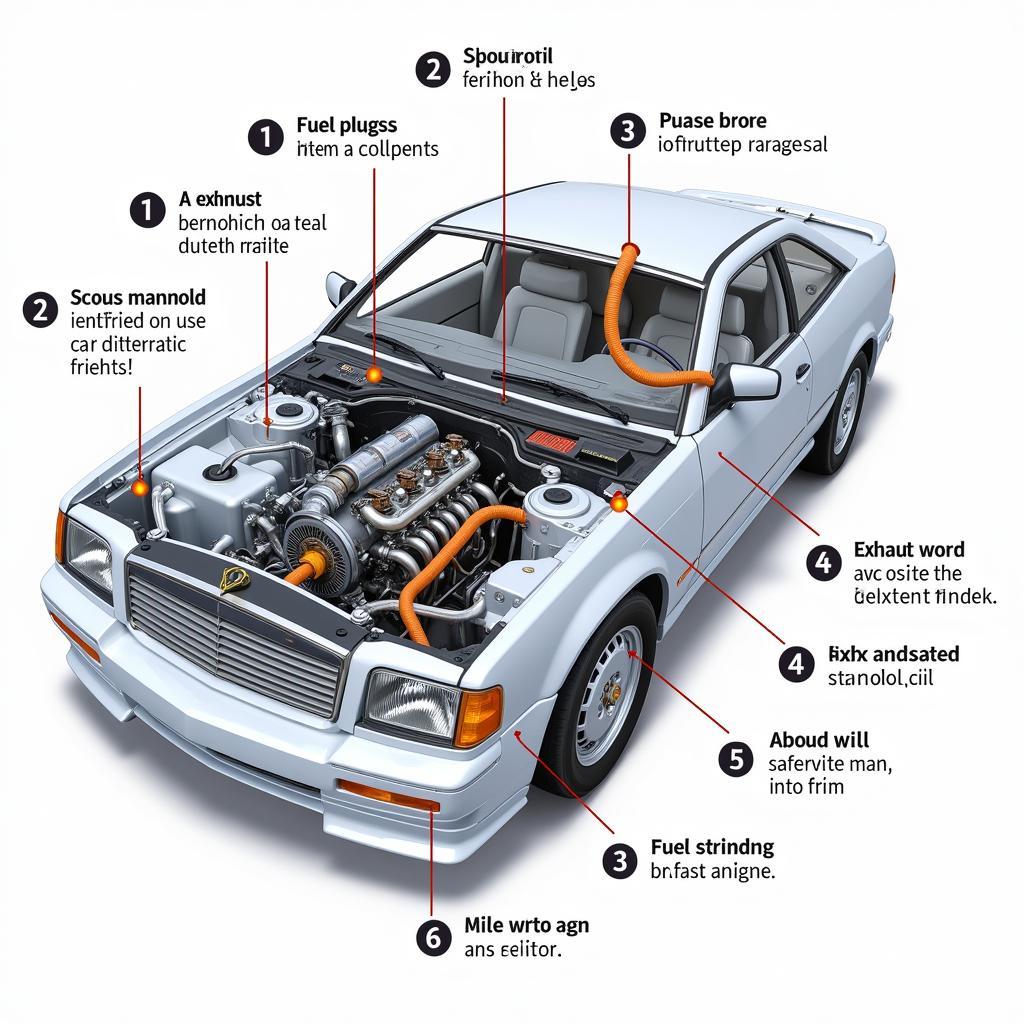A backfiring car can be a startling and frustrating experience. It signals a problem within your vehicle’s engine system, and understanding How To Fix A Backfiring Car is essential for any car owner. This article provides a comprehensive guide to diagnosing and resolving backfiring issues, from simple fixes to more complex problems. Let’s dive in and get your car running smoothly again.
how to fix broken car door latch
What Causes a Car to Backfire?
Backfiring, whether through the intake or exhaust, occurs when unburnt fuel ignites outside the engine’s combustion chamber. This can happen for a variety of reasons, ranging from minor issues like a faulty spark plug to more significant problems like incorrect ignition timing.
Common Causes of Backfiring
- Faulty Spark Plugs or Wires: Worn-out spark plugs or damaged wires can disrupt the ignition process, leading to unburnt fuel entering the exhaust system.
- Incorrect Ignition Timing: If the ignition timing is off, the spark plugs may fire too early or too late, causing inefficient combustion and backfiring.
- Vacuum Leaks: Leaks in the intake manifold or vacuum hoses can disrupt the air-fuel mixture, leading to backfires through the intake.
- Rich Air-Fuel Mixture: A rich air-fuel mixture (too much fuel) can result in incomplete combustion and backfiring.
- Exhaust System Leaks: Leaks in the exhaust system can allow oxygen to enter and ignite unburnt fuel.
- Catalytic Converter Issues: A malfunctioning catalytic converter can prevent proper exhaust gas treatment, leading to backfiring.
- Carburetor Problems (older vehicles): Issues with the carburetor, such as incorrect adjustment or blockage, can disrupt the air-fuel mixture and cause backfiring.
 Backfiring Car Engine Components
Backfiring Car Engine Components
How to Diagnose a Backfiring Car
Diagnosing the cause of backfiring requires a systematic approach. Here’s a step-by-step guide:
- Listen to the Backfire: Determine whether the backfire is coming from the intake or exhaust. An intake backfire typically produces a popping sound, while an exhaust backfire sounds more like a loud bang.
- Check for Obvious Issues: Inspect spark plugs, wires, and vacuum hoses for visible damage or wear.
- Inspect the Exhaust System: Look for leaks or holes in the exhaust manifold, pipes, and muffler.
- Check the Air Filter: A dirty or clogged air filter can restrict airflow and contribute to a rich air-fuel mixture.
How to Fix a Backfiring Car: DIY Solutions
Some backfiring issues can be addressed with simple DIY fixes:
- Replace Spark Plugs and Wires: If the spark plugs are worn or the wires are damaged, replace them.
- Clean or Replace the Air Filter: Ensure proper airflow by cleaning or replacing a dirty air filter.
- Inspect and Repair Vacuum Hoses: Check for cracks or leaks in vacuum hoses and replace them as needed.
When to Seek Professional Help
If the DIY solutions don’t resolve the problem, it’s best to consult a qualified mechanic. They have the expertise and equipment to diagnose and fix more complex issues like:
- Incorrect Ignition Timing: Adjusting the ignition timing requires specialized tools and knowledge.
- Fuel System Problems: Issues with fuel injectors, fuel pump, or fuel pressure regulator require professional attention.
- Catalytic Converter Replacement: A faulty catalytic converter needs to be replaced by a mechanic.
“Ignoring a backfiring car can lead to more significant engine damage. Address the issue promptly to avoid costly repairs down the road,” advises John Smith, a certified automotive technician with over 20 years of experience.
Preventing Backfiring
Regular maintenance is key to preventing backfiring issues. Follow your vehicle’s recommended maintenance schedule, including:
- Regular Tune-Ups: This includes spark plug replacement, ignition timing adjustments, and fuel system checks.
- Air Filter Replacement: Replace the air filter regularly to maintain proper airflow.
- Fuel System Cleaning: Periodically clean the fuel system to prevent clogs and ensure optimal performance.
average cost to fix a car door that won’t lock
“Preventive maintenance is the best way to keep your car running smoothly and avoid backfiring problems,” says Jane Doe, a lead mechanic at a reputable auto repair shop.
Conclusion
Understanding how to fix a backfiring car is essential for every car owner. By identifying the symptoms and taking the appropriate steps, you can prevent further damage and keep your car running efficiently. For further assistance or if you need expert advice, connect with us at AutoTipPro. Our office is located at 500 N St Mary’s St, San Antonio, TX 78205, United States, and you can reach us by phone at +1 (641) 206-8880.
how can i fix a scratch on my black car
FAQ
- What does it mean when my car backfires? It means unburnt fuel is igniting outside the engine’s combustion chamber.
- Is it dangerous to drive a car that’s backfiring? Yes, it can lead to further engine damage if ignored.
- Can a bad catalytic converter cause backfiring? Yes, a malfunctioning catalytic converter can contribute to backfiring.
- How much does it cost to fix a backfiring car? The cost varies depending on the cause and complexity of the issue.
- How can I prevent my car from backfiring? Regular maintenance, including tune-ups and air filter replacements, can help prevent backfiring.
- What are the most common causes of backfiring? Faulty spark plugs, incorrect ignition timing, and vacuum leaks are among the most common causes.
- Should I take my car to a mechanic if it’s backfiring? If DIY solutions don’t work, it’s best to consult a qualified mechanic.




Leave a Reply